8 Types of Cockroaches in South Carolina (With Pictures)
-

- Last updated:
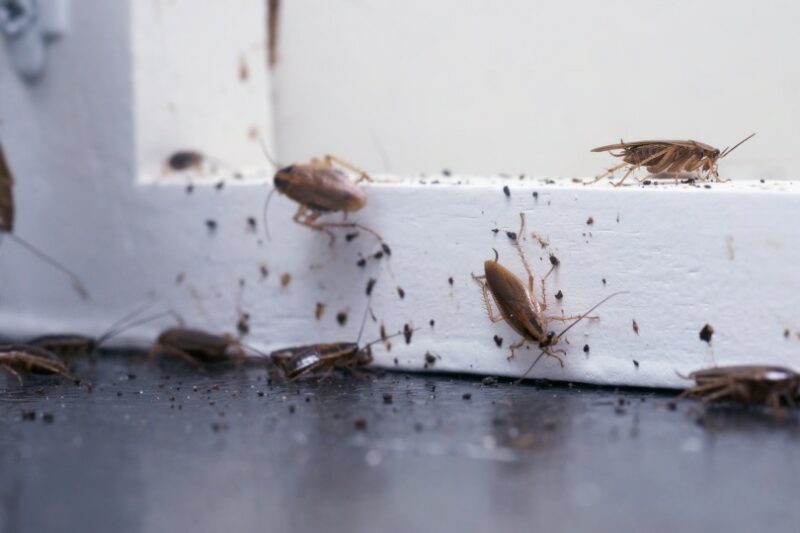
There are numerous cockroach species in South Carolina, but most homeowners probably don’t want to take the time to identify them if they show up in the house. A cockroach is a cockroach, so the logic goes, and you need to shoot first and ask questions later if you ask them at all.
It’s a fair reaction. Cockroaches are generally unclean, and there’s always the risk of nasty diseases and allergens spreading across the home. But not all cockroaches present the same issues, and you can save yourself a ton of trouble and money by understanding what kind is sitting in front of you. Learn all you need to know with this breakdown of eight common types of cockroaches you will find in South Carolina.
The 8 Types of Cockroaches in South Carolina
1. German Cockroach

| Scientific Name | Blattella germanica |
| Adult Length | 0.5–0.75 inches |
| Color and Characteristics | Tan, parallel dark streaks on head |
The relatively small, pale brown German cockroach is one of the most prevalent pests in the world. Originating from northern Africa, German cockroaches spread across the globe via trade and today inhabit every continent except Antarctica. Despite being highly intolerant of the cold, they survive nearly anywhere by depending on the warmth of human households.
German cockroaches are elusive and nocturnal, making it challenging to identify infestations. They’re a common health hazard. As they move around, they’ll spread bacteria and viruses and invade stored food, pet bowls, and any source of nutrition they can find.
Unfortunately, German cockroaches are challenging to control. Females can lay an egg case (ootheca) every 6 weeks and produce up to 48 eggs in each. Extermination is a challenge, as any surviving roaches can quickly repopulate a resistant colony.
German cockroaches are fast becoming immune to insecticides and already show resistance to 45 commonly used chemicals. Exclusion is crucial. Effective extermination requires an integrated approach with regular treatments and bait rotation.
2. American Cockroach
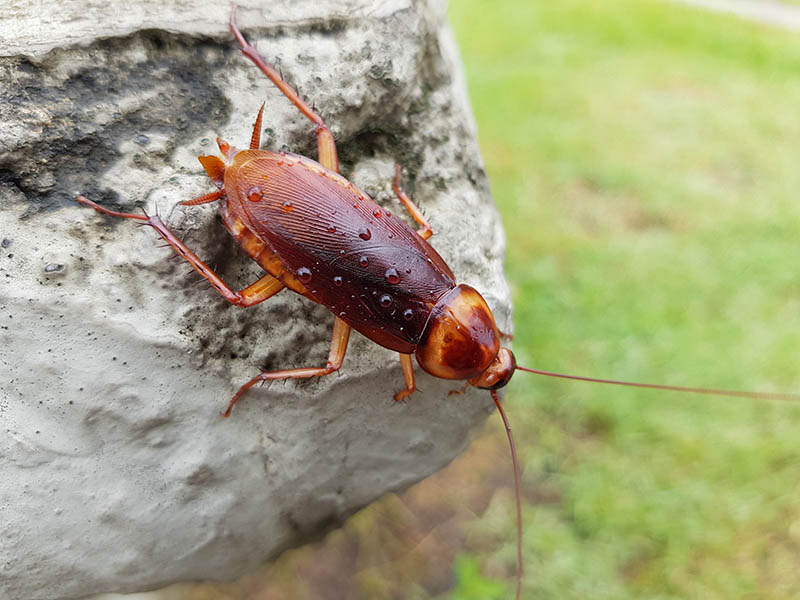
| Scientific Name | Periplaneta americana |
| Adult Length | 1.5–2 inches |
| Color and Characteristics | Shiny dark brown, “sunglasses” on prothorax |
The American cockroach is often called the palmetto bug in South Carolina for its habit of living around palmetto trees. The peridomestic cockroach lives inside sometimes but tends to inhabit damp, shady places outdoors, such as brush piles and mulch.
American cockroaches are the largest of the home-invading cockroaches in South Carolina. The dark brown roaches grow up to 2 inches long and are identifiable by the dark brown spots behind the head that look like sunglasses.
Despite having wings, American cockroaches aren’t strong fliers and will only occasionally glide from high places. They are exceptional runners, however, with a lightning-fast start speed and a pace of 3.4 mph. An adult can cover five feet (around 50 body lengths) in one second, explaining why they’re hard to spot after flicking on the light. A human running at that relative rate would be moving at over 200 mph!
Like German cockroaches, American cockroaches feed opportunistically. Though they prefer decaying organic material, they’ll eat all kinds of food and non-food substances, including glue, dead skin, and cardboard. Because they dwell in sewers, drainage systems, basements, bathrooms, and other dark, moist areas, they can also spread diseases throughout the home.
3. Smoky Brown Cockroach
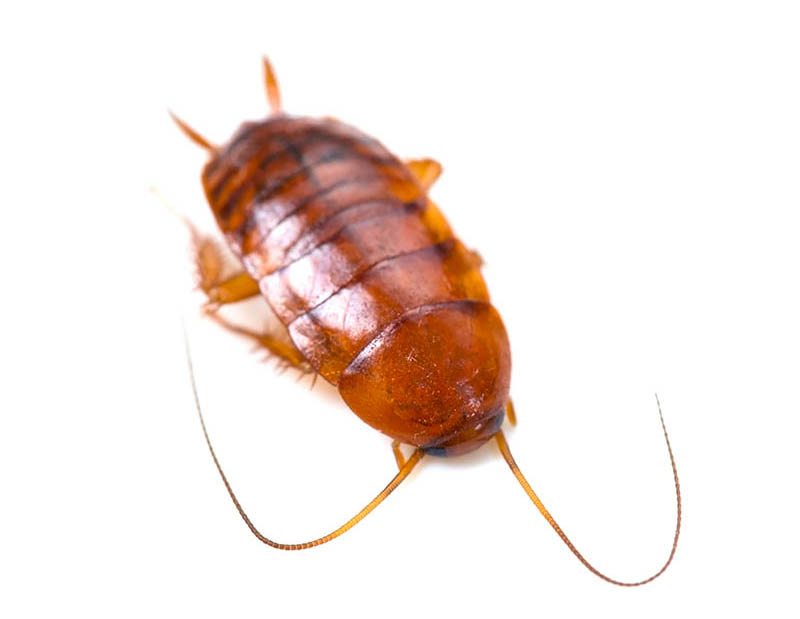
| Scientific Name | Periplaneta fuliginosa |
| Adult Length | 1.25–1.5 inches |
| Color and Characteristics | Brown/mahogany, uniform coloration |
Smoky brown cockroaches are spread across the world but are notably plentiful in Japan and the southern United States. They’re similar to the American cockroach and can be challenging to distinguish, especially if you’re trying to identify a live, moving roach in the kitchen.
You may make out minor distinctions, including the completely uniform coloration of the smoky brown cockroach and its ever-so-slight size difference. It lacks the lighter coloration around the edges and the apparent sunglasses pattern of its larger cousin.
Compared to American cockroaches, smoky brown cockroaches are better fliers and prefer the great outdoors. They dry out relatively quickly, relying on abundant moisture and high humidity to survive. Their activity increases with heat and humidity, so you’ll be more likely to see them take flight on a muggy summer evening.
Smoky brown cockroaches live in shady, moist areas outside, like mulch, leaf piles, and brush. As adept fliers, they can also fly up to treetops and roofs, and you might find them infesting your gutters or attic space. Unlike the American cockroach, smoky brown roaches are attracted to light and may soar through an open window at night to land on lamps and TV screens.
4. Oriental Cockroach

| Scientific Name | Blatta orientalis |
| Adult Length | 1-1.25 inches |
| Color and Characteristics | Shiny dark brown/black, plump body |
Originally from Africa, the Oriental cockroach is another widespread species in North America, inhabiting dark, moist areas like mulch beds, wood piles, drains, and sewers. Although it lives primarily outdoors, this peridomestic roach will find its way inside by following drains, sewer lines, and plumbing to enter a home.
Also called the waterbug, Oriental cockroaches depend on moist environments. Around the home, you may find them around toilets, sinks, laundry rooms, and pipes.
Oriental roaches are less agile than most species. They are slow-moving and poor at climbing, preferring to invade at ground level through drains, service ducts, and doorways. Males have stunted wings, making them weak fliers, and females have no wings.
While it’s unlikely that Oriental cockroaches will move past your home’s ground floor (if they enter at all), removal is vital to maintain your home’s safety and comfort. Oriental cockroaches spend much of their life in filth and carry a host of bacteria, viruses, and fungi across surfaces in the home.
You may notice a potent musty odor if you have a substantial Oriental cockroach problem. While all cockroach species emit oleic acid to communicate and attract more roaches, Oriental cockroaches give off a more powerful aroma to alert you to their presence.
5. Brown-Banded Cockroach
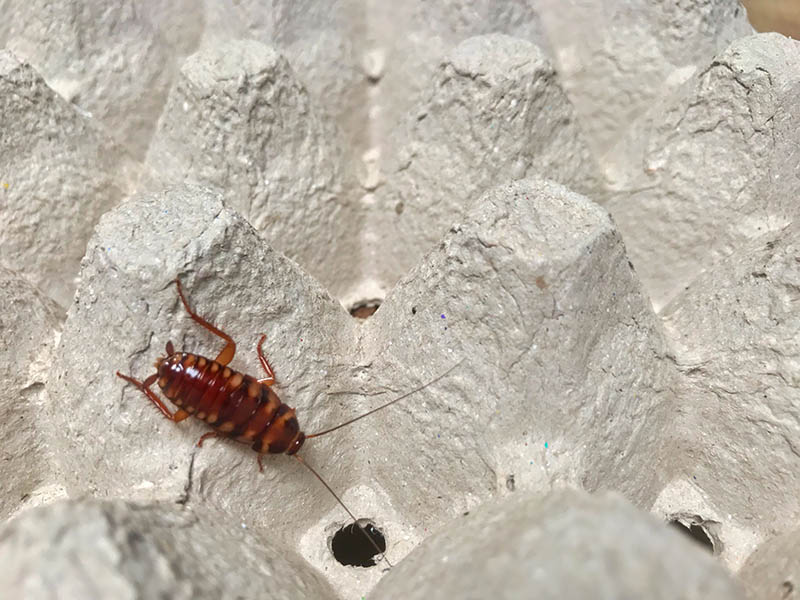
| Scientific Name | Supella longipalpa |
| Adult Length | 0.5 inches |
| Color and Characteristics | Light brown, two bands across body |
Brown-banded cockroaches are the smallest of South Carolina’s cockroaches. Originating from Cuba, the species entered the United States through Florida in the early 1900s and has since spread across the continent.
As a domestic species, brown-banded cockroaches can be a particular nuisance in the home. While most cockroaches prefer moist, dark locations, these tiny roaches occupy dry locations. You’ll find them in numerous places, including upper cabinet areas, desk and cabinet drawers, furniture, and appliances.
Brown-banded cockroaches are more likely to appear in living rooms and bedrooms than most cockroach species. They eat a broad array of materials, making them particularly damaging if you have a large infestation. Though they prefer food and decaying organic matter like other species, they’ll consume trash, fabrics, cardboard, dyes, and pastes, such as envelope adhesive or wallpaper glue.
6. Australian Cockroach
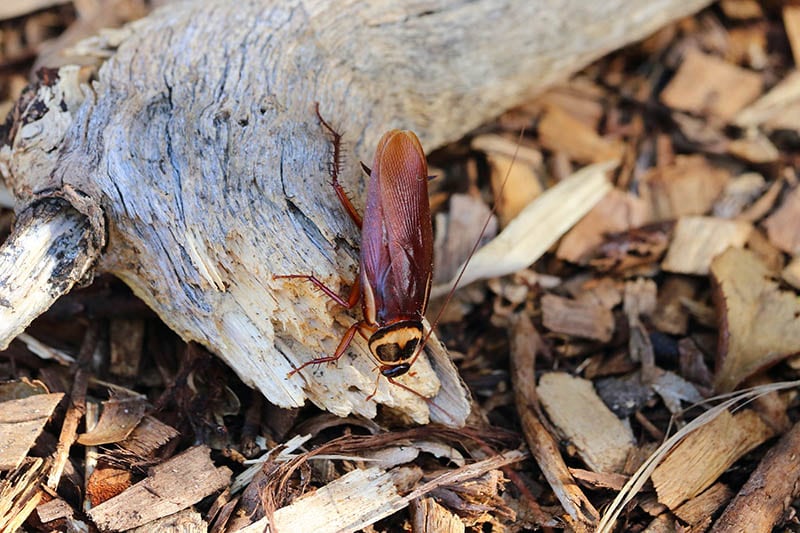
| Scientific Name | Periplaneta australasiae |
| Adult Length | 1.25–1.5 inches |
| Color and Characteristics | Brown, light head shield with dark brown center |
The Australian cockroach resides across the southeastern U.S. as far north as South Carolina. It is easy to confuse the Australian and American cockroaches, especially given the similar sunglasses pattern on their heads. If you get close enough, you’ll notice the Australian cockroach has two light-colored bands running along the upper edges of the wings, which are absent from the American roach.
Although they aren’t as pesky as German cockroaches, Australian cockroaches have an impressive reproductive rate. Females don’t carry the ootheca with them like many other species, instead attaching it to hidden damp areas. They can produce one ootheca every 1–2 weeks and up to 30 in their lifetime.
Australian cockroaches live outdoors in damp tree stumps, brush, and wood piles, much like the smoky brown cockroach. In colder South Carolina winters, they may come inside to inhabit warm, damp, and dark areas in bathrooms and cabinets. Male and female adults are nocturnal, fast, and capable of flight, making them as elusive as American roaches.
7. Asian Cockroach
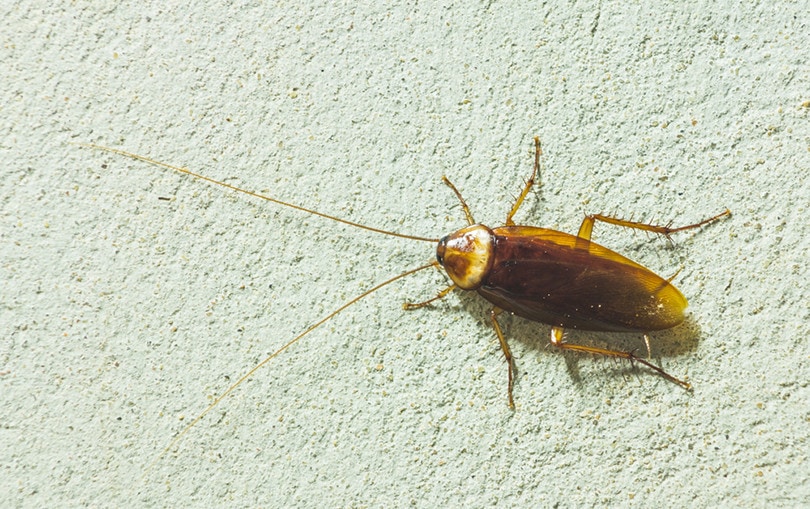
| Scientific Name | Blattella asahinai |
| Adult Length | 0.5–0.75 inches |
| Color and Characteristics | Tan/dark brown, longer wings than German cockroach |
Asian cockroaches are a relatively new species, first detected in Japan in the early 1980s and appearing in the United States in 1986. It looks nearly identical to its close relative, the German cockroach, but features longer wings extending past its body.
Though they look like German roaches, Asian cockroaches have far different habits. They are capable and willing fliers able to sustain flight for up to 120 feet and prefer to live outdoors. Outdoor colonies appear in mulch, compost, lawn debris, and landscaped areas, with massive numbers developing. Collections have appeared with up to 250,000 roaches per acre.
Though perhaps even less likely to invade your home than the smoky brown cockroach, Asian cockroaches may fly inside if they’re attracted to a light source. Proper identification is essential if you find Asian cockroaches in the house, as they use different access points than German cockroaches and have unique pesticide tolerances.
8. Surinam Cockroach
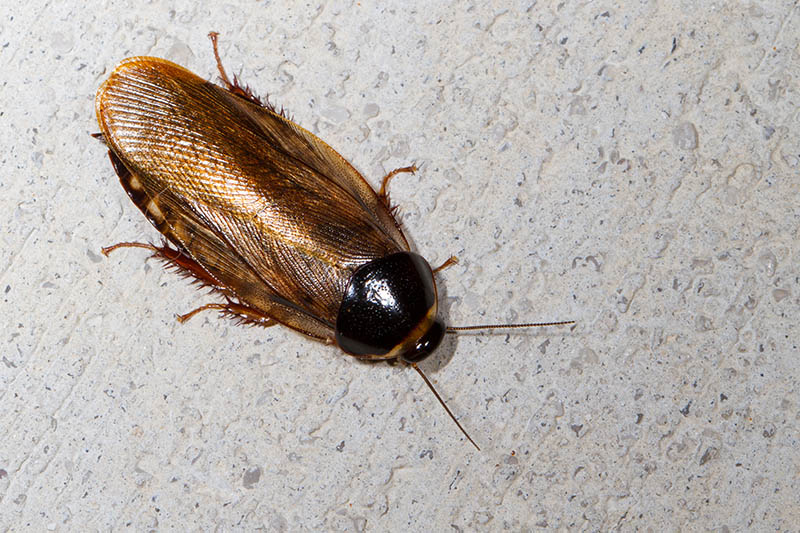
| Scientific Name | Pycnoscelus surinamensis |
| Adult Length | 0.75–1inches |
| Color and Characteristics | Dark brown/black, olive green/dark brown wings |
The Surinam cockroach, aka the greenhouse cockroach, prefers warm, moist areas like the garden and greenhouse. They aren’t omnivores and focus primarily on plants for sustenance.
While the burrowing species isn’t as much of a pest as most cockroaches, Surinam cockroaches could come indoors inadvertently if they’re hiding in potted plants. You might not need to worry about invaded pantries in South Carolina, but these roaches may appear in an attractive garden or humid greenhouse and destroy your plants.
Interestingly, there are no male Surinam cockroaches in the U.S., yet the species continues to thrive in a range extending coast-to-coast across the southern states. The flightless females reproduce asexually through parthenogenesis, so they don’t need males.
 Tips for Preventing Cockroaches in South Carolina
Tips for Preventing Cockroaches in South Carolina
Over a dozen cockroach species call South Carolina home, but in most cases, you’ll only encounter the handful of domestic or peridomestic bugs listed here. Identification is crucial before formulating a control plan, as various species have different habits and present unique threats.
Fortunately, a comprehensive prevention plan will indiscriminately bar cockroaches of all kinds from entering your home. Follow these tips to make your house inaccessible and unattractive to roaches:
- Clean the sink and wash the dishes every night
- Clear crumbs and spills from counters and kitchen floors
- Take the trash out every night and ensure the garbage bin has a tight-fitting seal
- Store foods like cereals, sugar, and flour in airtight plastic containers
- Seal small cracks and gaps around the home with silicone caulk or concrete patch
- Install weather stripping around exterior doors and windows
- Vacuum regularly and maintain a high standard of cleanliness
- Fix leaking faucets, water spigots, and pipes around the home
- Run a dehumidifier as needed to keep relative humidity below 50%, especially in the basement
- Remove clutter around the house and replace cardboard boxes with sealable plastic containers
- Clear brush, leaf piles, and other cockroach hiding spots from near the home, keeping a clear space about 2–3 feet around the perimeter
- Inspect boxes, potted plants, and other outdoor items before bringing them inside
- Add screens to weep holes in brick walls
- Remove birdbaths and other standing water sources around the property
- Check for potential moisture sources like poor draining slopes and clogged gutters

Your primary goals are to remove food, water, hiding places, entry points, and bridges into the home. Nevertheless, determined cockroaches can be downright impossible to keep out. You may still see an infestation in even the cleanest, most well-protected home.
If you find a cockroach in the home, identification is critical to understand the threat and potential solutions. Contacting a professional is often an essential first step. German cockroaches are a particular challenge to control for most homeowners. Hiring an expert is the quickest, safest, and most inexpensive way to handle cockroach infestations.
Find a pest-control specialist in your area, and get free, no-commitment estimates for your project.Consult a PEST-CONTROL expert

In Conclusion
South Carolina boasts a rich assortment of wildlife, which you might see as a negative when considering the number of cockroach species in the state. But the appeal comes from the gorgeous weather, and most cockroaches are happy to spend their entire lives outside and away from people. With proper preventative steps, you can substantially reduce your risk of infestations. Use these tips on identifying and dealing with cockroaches in South Carolina, and you’ll see they’re not as scary as they seem.
See Also:
- What Are Florida Flying Cockroaches?
- 5 Types of Cockroaches in Massachusetts
- 6 Types of Cockroaches in Tennessee
Featured Image Credit: IrinaK, Shutterstock
Contents

 Tips for Preventing Cockroaches in South Carolina
Tips for Preventing Cockroaches in South Carolina